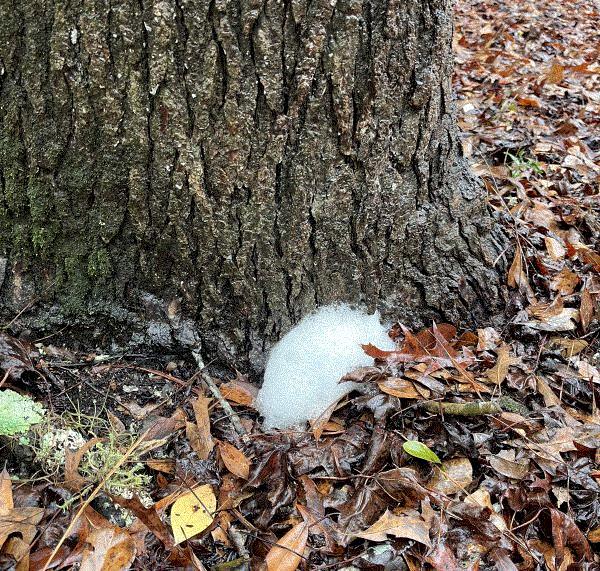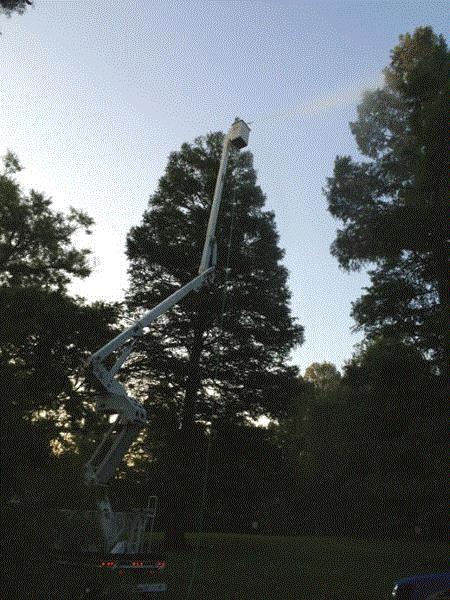What the ... ?
I'm holding back on sharing the mystery I’m disclosing today because I want to see if I can figure it out before I share it with y’all. I’m no closer to an answer after more than a month, so I’m going to enlist your help, my wise counsels, on what in the world happened to a couple of southern red oak trees in my front yard.
We saw a pretty wet and warm period in Back Swamp, South Carolina, between Christmas and New Year. I was hauling firewood from the shed to the house when I saw out of the corner of my eye what seemed to be a lion’s mane mushroom at the base of a mature southern red oak tree by the driveway. I thought, “Sweet! Something extra for dinner.”

After stacking up the firewood, I went back to the tree with the hope of harvesting some edible mushrooms and realized that, heck, that’s no mushroom! It was just a pile of bubbles! Of course, I also forgot that December is past the season for harvesting lion’s mane. (Did I mention I didn’t wear my glasses when I drove by the first time?)
This wasn’t the only pile of bubbles. I also found a smaller one on another southern red oak tree no more than 20 ft. from the first one. This one was oozing out of an obvious hole about waist high and the bubbles were running down the side of the tree.
I chalked it up as guttation at the time, considering the soil was saturated with water and it was warm enough for some sap movement. But it wasn’t a satisfying answer for me. So I searched online, on and off, trying to see if I’d come across an answer. Lots of folks reported seeing something similar on a wide range of tree species. As I mentioned earlier, I had no luck finding a good answer as to why or what.
Have you seen this phenomenon before? What could be causing the trees to ooze out bubbles like that? Email me and let me know! I’ll share everyone’s answer in the next issue.
Thanks in advance!

How Longwood Gardens Does IPM
Many of you have been to, or at least know about, Longwood Gardens in Kennett Square, Pennsylvania. I've been there several times and particularly enjoy the grand Conservatory, understandably, because of my background in greenhouse and floricultural entomology.
I never really walked Longwood’s 300-acre core gardens, let alone the entirety of nearly 1,100 acres. I looked around during my visits and often wondered how in the world the staff at Longwood do pest management. It’s an enormous challenge—as big as the property.
My question was answered in November 2024. Rachel McDonald and Beth Pantuliano, both of Longwood’s IPM team, published a review of the pest management approaches at Longwood Garden in the Journal of Integrated Pest Management. Go HERE for a copy of the article. Don’t worry—this journal is open access, meaning that y’all don’t have to pay to read the articles contained within. Also, the articles and reviews are usually written in plain, simple language (Rachel and Beth’s article certainly is) so that it’s accessible not only to scientists, but also anyone interested in the topic.
Check out the Journal of Integrated Pest Management if you want to know all the details about various pest management topics, such as the potential economic impacts of spotted lanternfly to New York State’s grape industry and pollinator conservation in urban environments. You want to know more about potential pests and diseases of mung bean? Well, there’s an article on that!
Rachel and Beth start their article with a review of the history of Longwood Gardens and the pests they encounter on a daily basis. (Did you know that Pierre du Pont purchased the core of what’s now Longwood Gardens in 1906 and that mites, thrips, aphids, whiteflies and mealybugs are the banes of the IPM team’s existence?) Then they briefly go through the process of developing an IPM program for the core area of Longwood and the challenges they face while using traditional IPM practices. (Pest forecasting is a big challenge; so is prioritizing potential plant healthcare concerns when you have 300 acres to manage.)
There are certainly unique pest management challenges that public gardens must endure and find solutions to, particularly at Longwood where historical legacy must be balanced with the concept and management of a modern garden. The equation becomes more complicated when you include the potential and experienced impacts of climate change in southeastern Pennsylvania.

I often joke about what a bad idea it is to spray pesticides from a cherry-picker. But I guess you have to do so if that's the only way to get around some constraints. (Photo Credit: Longwoods Gardens.)
The IPM team at Longwood also must work around the constant changes at the gardens and the demands put on the IPM program from various special events, such as the famous Christmas light display. It’s not just the open hours or the visitors that can throw a wrench into the best-laid plans; nature and other human elements also conspire to cause additional challenges for the IPM team.
Rachel and Beth share their experience, insights and lessons learned in this very well-written article. There are lessons that are unique to Longwood Gardens, but there are also many more lessons that can be adopted by other public gardens. If you manage a public garden, check out this article by going HERE.

Do Biocontrols? February’s GrowerTalks is a Must-Read
This is not a bait-and-switch tactic. The February issue of GrowerTalks is truly chockfull of articles and information on how to do biological control right. If you're running a biological control program, it’s well worth a visit.
Here are some highlights:
Suzanne Wainwright-Evans (a.k.a. the Bug Lady) and Maria Diaz (of Beneficial Insectary) co-authored an article on what Beneficial Insectary does to make sure that beneficial insects arrive at your door alive and ready to do its damage to pest populations. Lots of considerations go into this seemingly simple activity, from packing to temperature maintenance to data processing. (Hint: It’s certainly not like some online retailers ship out their non-perishable goods.) The article also goes through the process of inspecting temperature and viability on the receiving end. The grower checklist is particularly brief, but important.
Rose Buitenhuis of the Vineland Research and Innovation Centre talks about using cutting dips as an effective and economic way of reducing thrips infestations while finishing crops. In addition to describing the process, Rose also dispels concerns of disease transmission (in dipping solution) by talking about research that she and her colleagues have conducted.
Jeremy Webber of Koppert introduces the predatory mite, Amblydromalus limonicus, and its efficacy in controlling thrips, such as western flower thrips and Thrips parvispinus.
There are other pest management-related articles in the February issue of GrowerTalks. Raymond Cloyd of Kansas State University introduces us to bulb mite, which I also noted as a pest that’s becoming more prevalent in tissue culture and propagation. Heidi Lindberg of Michigan State University Extension reviews the biology and management of broad mites. And Josh Henry of Ball Seed Company compares adjuvants, surfactants and wetting agents. Do you know that they are different? If not, check out Josh’s article.

Biocontrol Webinar From AFE
Don’t feel like you’re well-equipped even after reading the February issue of GrowerTalks? Here's another opportunity to learn more about the practical how-tos of running a biological control program.
Join Suzanne Wainwright-Evans at 1:00 p.m. Eastern/noon Central on March 25 for a webinar on how to use beneficial insects right. Suzanne will be talking about the practical aspects of biocontrol, from receiving to releasing beneficial insects, so that you can have a successful program.

This webinar is part of the American Floral Endowment’s Grow Pro Webinar Series. Suzanne’s webinar in March is sponsored by Costa Farms. Go HERE to register.
PGR Guide for Annuals is Now Available
You can get a copy of GrowerTalks’ 2025-2026 Plant Growth Regulator Guide for Annuals by going HERE. This year’s PGR Guide is edited by Brian Whipker of North Carolina State University and sponsored, as in the past, by Fine Americas.
The 2025-2026 PGR Guide retains a great introduction of PGRs available for use on ornamental crops, co-authored by Brian and Joyce Latimer of Virginia Tech, from the previous issues. I think this is an essential document that should be printed or saved on your computer hard drive. I refer to this document regularly for the characteristics (such as application types and absorption sites) and comparisons among PGRs.

The biggest chunk of the 2025-2026 PGR Guide is occupied by an extensive table of PGRs used on floricultural crops in greenhouses, compiled by Brian. (A similar table focused on containerized herbaceous perennials was featured in the 2024-2025 PGR Guide for Perennials.) This table has PGRs available for specific production goals, suggested rates, and precautions and other remarks of just about all the greenhouse ornamental crops y’all are growing. This is an easily accessible table that’ll help you grow wonderful crops. Of course, as Brian will also point out, you’ll need to try different rates of any PGR before you make a broadcast application because the rates are just that: suggestions. You’ll have to find the right rate for your site, your crops and local environmental conditions.
Brian also contributed several articles in this guide. Two articles explain how to grow common greenhouse crops, such as geraniums, petunias and coleus using spray and drench of Collate 21 (21.7% ethephon). Another article provides rates for improving rooting of plugs with Advocate (20% IBA).
In the Reference Section, Brian has included several articles (by himself or co-authored with other researchers) outlining the additional benefits of PGRs and tips on using Piccolo 10XC (paclobutrazol), Fesco (benzyladenine + gibberellins), Folorgib 4L (gibberellins) and Abide (ancymidol). Don’t miss the dilution table for many PGRs at the end of the guide. Great colored photos accompanied these articles.
Again, go HERE to get a copy of the 2025-2026 PGR Guide for Annuals.

That’s When You Know You’re Going Nowhere
Many southerners are still tramatized by the snow-pocalypse during the week of January 20. I mean, not very many of us know what to do when the white stuff falls down from the sky and accumulates on our streets and driveways.
I was on my way to Portland, Oregon, to give a talk at Wilbur University. The picture below showed what was outside of my window when my flight landed in Atlanta.

If there was an “OH, DEAR!” moment, that was it. (Okay, those of you who had heard me gave a talk before know that I'm more colorful than "Oh, dear.") Needless to say, my travel plans were thrown into complete chaos at that moment. I made it to Portland the next day and gave my talk near the end of the event, thanks to some schedule shuffling by the nice folks at Wilbur-Ellis.
Just thought I’d share a humbling moment from the life of a road warrior ...
See y'all later!

JC Chong
Technical Development Manager at SePRO
Adjunct Professor at Clemson University
This e-mail received by 27,847 subscribers like you!
If you're interested in advertising on PestTalks contact Kim Brown ASAP!